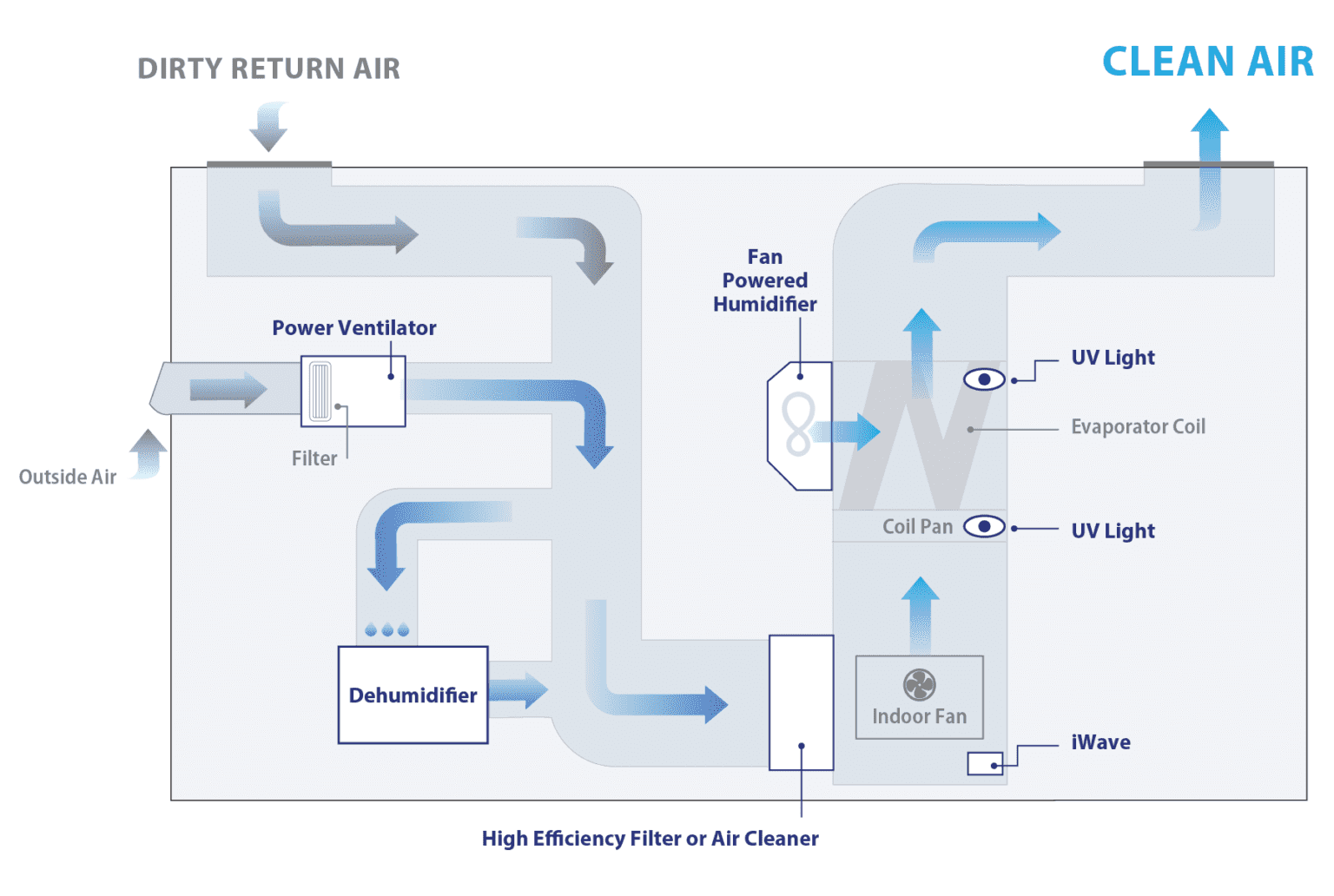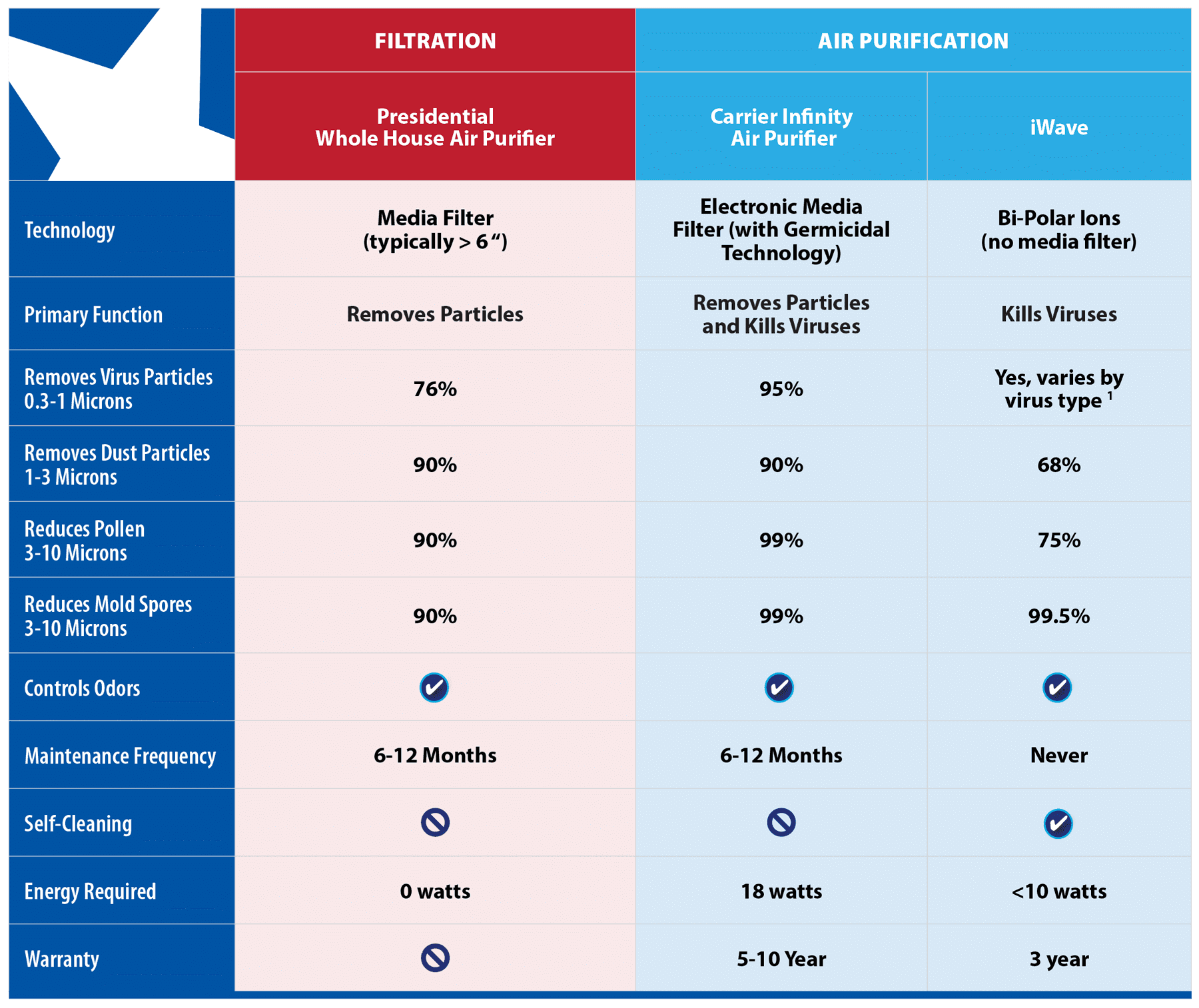
Indoor Air Quality in Gaithersburg, MD
The Presidential Heating and Air Conditioning, Inc. team of experts, has been helping families and businesses live and work more comfortably since 1982. We understand the importance of removing contaminants from the air we breathe. Our experts can help customize a solution that is right for your specific environment by providing insight on quality products, such as those offered by AprilAire.
Understanding The Quality Of Air In Your Home
We spend approximately 90% of our time indoors. Understanding, and improving, the quality of the air we breathe is important to our overall health. A growing body of scientific evidence has indicated that the air within our homes can be seriously more polluted than the outdoor air in even the largest industrialized cities. The Environmental Protection Agency (EPA) has concluded there are typically 2-10 times more pollutants indoors than out-of-doors. The EPA considers indoor air pollution the number one environmental health problem in the United States and have determined these pollutants are responsible for as much as 50% of all illnesses.
What Is Polluting The Air In Your Home?
Indoor pollutants can be placed into two groups, biologic and chemical. Biologic pollutants include bacteria, molds, viruses, animal dander, cat saliva, dust mites, cockroaches, and pollen. These biological pollutants can be related to some serious health effects including shortness of breath, dizziness, lethargy, and even digestive problems.
Allergic reactions are the result of repeated exposure and immunologic sensitization to particular biologic allergens. Asthmatic responses to pollutants can be life-threatening. Chemical pollutants include tobacco smoke and volatile organic compounds, or VOCs.
VOC’s are organic chemicals that vaporize and become gases at normal room temperatures. Examples of common items that release VOCs include: cleaning products, paints, varnishes, disinfecting and air freshening products, building materials, home furnishings. If not enough outdoor air is brought indoors, emissions from indoor sources cannot be diluted or carried out of the home. This increases indoor air pollutant levels. Temperature and humidity levels can also increase the concentration of some pollutants.
Common Indoor Air Issues | |
Issue/Source | Symptom |
| Biological Pollutants Pets, dust mites, mold, pollen, animal dander | Known to trigger and worsen asthma and allergy symptoms |
| Chemical Pollutants Cleaners, paints, adhesives, pesticides, cosmetics, air fresheners | Nausea and headaches. At high levels, can cause eye irritation |
| Relative Humidity Too much or not enough moisture in the air | Too Moist – Mold and dust mites, warping of wood furnishings Too Dry – Nosebleeds, dry eyes and skin, cracking of wood furnishings |
| Mold and Bacteria on the Cooling Coil Dampness | Known to trigger and worsen asthma and allergy symptoms, coughing, respiratory issues |
How To Improve Indoor Air Quality
Indoor air can be riddled with allergens such as pollen, dust mites, dirt, and mold spores. According to the U.S. Environmental Protection Agency (EPA) there are typically 2-10X more pollutants inside your home than outside. The EPA considers indoor air pollution to be the #1 environmental health problem in the United States and responsible for as much as 50% of all illnesses.
Air quality in your home can be improved by:
- Bring more fresh air into your home
- Remove biological pathogens, chemical pollutants, allergens, dirt, and dust by cleaning your home and air duct systems
- Kill viruses (including Coronavirus)
- Add humidity in the winter
- Remove humidity in the summer
- Remove humidity from damp locations
- Prevent mold and bacteria from growing on your equipment
- Improving ventilation and air circulation
Building The Right Air Purification System
There is a wide variety of air purifying products on the market today. Each type is designed to perform a specific function and treat specific problems.
Presidential’s team of experts have been helping families determine the right product or combination of products for their homes since 1982. From diagnostics to maintenance, to repair, to installation, we do it all. We will not only get your air conditioning unit working at its maximum efficiency but through the installation of indoor air quality products and systems, we will improve your health and save you money on your energy bills!
There are a variety of components that help achieve and maintain healthy indoor air quality. The various components work in conjunction with each other though not all are necessary for every environment.
The first step is to improve the quality of the air inside your home is to have a professional Indoor Air Quality expert test and evaluate it. Once they have all the facts they can recommend the appropriate Indoor Air Quality component for your environment.
Diagram of Indoor Air Quality Product Installation in a Residential Heating and Air Conditioning System
Indoor Air Quality Products
Ventilators, Filters, Purifiers, Humidifiers, Dehumidifiers, and Cleaners
Your heating, ventilation, and air conditioning (HVAC) system does so much more than simply heat and cool your home. A technologically advanced HVAC system also keeps the humidity at a comfortable level all year long. With a professionally installed HVAC system, your home or business’ temperature and humidity can be perfectly balanced.
Ventilators. A fresh air ventilation system brings fresh air from the outside into the home, disrupting and diluting stagnant indoor air. Fresh air is brought into the home through vents on the outside of the home. The fresh influx of air stirs the standing air diluting and moving odors, moisture, and contaminants through the air and into the filtration system. Some ventilators work with a home’s existing duct work and can be programmed to bring in the recommended amount of fresh air while minimizing energy usage and monitoring humidity levels.
Filters. The air filter is typically located at the point where the return duct enters the air handler. Their basic function is to clean the air that circulates through the heating and cooling system. Filters trap and hold many types of particulates and contaminants that could affect your health and comfort. There are two types of filters – MERV and Media.
MERV Filters. These filters are rated via the Minimum Efficiency Reporting Value (MERV) system. This system evaluates the efficiency of an air filter based on how effective it is at catching particles of varying sizes. MERV ratings range from 1-20, with 1 being the lowest level of filtration, and 20 being the highest. MERV 16 through 20 are usually only found in hospitals, cleanrooms, and nuclear power plants. Effective home air filters are rated anywhere between MERV 5 and 13, though we are seeing some MERV 16 for home air filters. MERV Filters are disposable and replacement frequency will vary from monthly to half-yearly depending upon the home and filter choice.
Media Filters. Sitting between the main return duct and the blower cabinet, media filters are deeply pleated, paper-like material, that is at least seven times more effective at removing dust and other particles including flu viruses.
While usually no wider than six inches, the pleated material can cover up to 75 square feet when stretched out. This increased area of filtration accounts for the filter’s long life and ability to capture more contaminants. The media filter’s tight weave can restrict the HVAC system’s ability to blow air through the home. It’s important to seek the advice of a heating and air conditioning professional to insure the media filter chosen doesn’t put a strain on the HVAC system.
Media Filters are disposable and replacement frequency will vary from 6 months to 1 year depending upon the home and filter choice.
Air Purifiers. Installed inside the HVAC air duct, an air purification system attracts and kills molds, bacteria, allergens, and viruses as the air flows through, and with some models, just past the system. They also reduce, smoke, static electricity, and everyday odors from pets and cooking. Independent testing on certain Air Purification Systems has shown to significantly (up to 99%) inactivate captured viruses and germs including CORONAVIRUS.
Air Purifiers are both disposable and permanent depending upon the make and model. Replacement frequency on the disposable filters is typically every several months to a year.
Humidifiers. There are three types of humidifiers – Fan-Powered, Steam, and Bypass. All three add moisture, primarily in the winter months. Maintaining proper moister levels reduces colds and flu, relieves itchy, dry, and cracked skin, dry nasal passages, static electricity, and protects hardwoods, musical instruments, and electronics from drying out and cracking. The fan-powered and bypass models deliver water vapors into the duct. Steam models deliver high temperature water vapors into the duct through dispersion tubes.
Dehumidifier. Whole-house dehumidifiers mount in the duct to your existing HVAC system to effectively transfer dry air evenly throughout your home and thus remove excess moisture. Excess moisture can be found in the home due to a variety of reasons; crawlspaces and basements, sealed up attics, reduced run times on air conditioning systems.
Dehumidifiers are most commonly used in summer months when humidity levels are higher. It’s important to note, that all these components only work while the HVAC system is in operation. In a lot of cases, homeowners only run their systems on average 25% of the time. Running the fan for longer periods will increase the removal of both biological and chemical pollutants as well as maintain the proper moisture levels.
Ultraviolet Germicidal UV Lights. UV Lights are mounted inside the HVAC system near the indoor cooling coil. As cold and warm air pass through the system, mold, and bacteria can grow in the condensation left behind. Left untreated these mold spores and unpleasant orders can be spread throughout the home.
UV Lights kill the bacteria and mold located on or around these coils and the drain pan preventing these spores from circulating throughout your home. UV Lights are easily maintained with the lights replaced every 1-2 years.
| Common Indoor Air Solutions | ||
| Issue/Source | Symptom | Solution |
| Biological Pollutants Pets, dust mites, mold, pollen, animal dander | Known to trigger and worsen asthma and allergy symptoms | Filter Media Filter Air Purifier |
| Chemical Pollutants Cleaners, paints, adhesives, pesticides, cosmetics, air fresheners | Nausea and headaches. At high levels, can cause eye irritation | Ventilator |
| Carbon Dioxide Breathing, burning candles, gas, wood and other combustibles | Drowsiness, poor circulation | Ventilator |
| Relative Humidity Too much or not enough moisture in the air | Too Moist – Mold and dust mites, warping of wood furnishings Too Dry – Nosebleeds, dry eyes and skin, cracking of wood furnishings | Dehumidifier Humidifier |
| Mold and Bacteria on the Cooling Coil Dampness | Known to trigger and worsen asthma and allergy symptoms, coughing, respiratory issues | UV Lights |
Below is a description of the air purifying products we have found to be the most effective. A complete air purification system includes: filtration, coil protection, and an air purifier.
Aprilaire® Fresh Air Ventilator
Pulling fresh outdoor air into your home or business through the HVAC system, this fresh influx of outdoor air mixes with the stagnant air and pushes allergens, bacteria, mold, chemicals and odors out through kitchen vent hoods, fireplaces and bathroom exhausts.
Basic Filter
Basic 1” filter that comes standard with most HVAC systems and are replaced monthly.
Presidential Whole Home Air Purifier (Merv13)
Precision point ionization charges particles as they enter the continuously charged media capturing the particles. The patented technology then kills the captured viruses, bacteria and mold preventing further growth of bacteria and fungi on the filter.
Carrier Infinity Air Purifier
Precision point ionization charges particles as they enter the continuously charged media capturing the particles. The patented technology then kills the captured viruses, bacteria and mold preventing further growth of bacteria and fungi on the filter.
IWave-R
A patented technology installed in any ducted air conditioning system, needle-point bi-polar ions are produced as air passes over the device killing or reducing pathogens, allergens, particles, smoke and odor in the air without creating ozone or any other harmful byproducts.
Air Purification Comparison Chart
The following chart compares the various filtration and air purification products and their increased level of effectiveness of removing various contaminants from your home and office environment.
- Please refer to manufacture for detailed information. EMSL Labs, a laboratory rated as “Elite” by the Center for Disease Control, has tested the effectiveness of iWave products against the pathogens listed. All testing was done in a large environmental chamber in an effort to simulate a home environment. Staph: Reduced 96.24% after 30 minutes of iWave purification MRSA: Reduced 96.24% after 30 minutes of iWave purification E.Coli: Reduced 99.68% after 15 minutes of iWave purification Clostridium Difficile (C.Diff): Reduced 86.87% after 30 minutes of iWave purification Tuberculosis: 69.01% after 60 minutes of iWave purification Legionella Pneumophila: Reduced by 99.71% from solid surfaces after 30 minutes of iWave purification Airborne Mold Spores: Reduced 99.5% by iWave purification (tested by Green Clean Air)
See What Your Neighbors Are Saying
-
"AC is now working great. Thomas saved me thousands."
Called Presidential and they sent Thomas the next day. He was thorough, cordial and professional. Explained each step.
Terry B. -
"Kind, considerate, and fixed it quickly."
My heater stopped working yesterday, and I called Presidential Heating & Air Conditioning. They sent someone out today who was kind, considerate, and fixed it quickly. Their prompt and caring service is much appreciated.
Christine V. -
"What excellent customer service!"
Our AC motor blower blew out right before the hottest day of the year. Presidential took care of us as quickly as possible. The front office was very helpful and the tech replaced everything in less than a day. It was quite remarkable. We appreciate it!
Matt A. -
"Prompt, pleasant and professional."
Got an appointment within 24 hours of my call! The technician was prompt, pleasant and professional. I have used Presidential in the past and will continue to use their services in the future if needed.
Denise B. -
"PH&AC was very quick to come out and help us"
Rinard (our tech) was very professional, courteous, and got us repaired in good time.
Marc -
"I will definitely call them again if needed."
The first impression is always important, and, in my case, it was very good.
Michael I.

Carrier Whole House Humidifier
Humidity controls monitor the moisture levels in your home or business. When needed, water flows over a distribution tray in which the dry, hot air of your environment passes, creating vapors that are circulated throughout your home or office reducing the transmission of viruses by up to 30% and reducing asthma flares.
Aprilaire® Whole House Humidifier
Dry, hot air from your home or office is moved through the HVAC system and over a moisture-laden water panel creating vapors that are circulating throughout your home or office reducing the transmission of viruses by up to 30% and reducing asthma flares.
Aprilaire® Whole House Steam Humidifier
Delivering humidity in the form of steam through dispersion tubes mounted in the HVAC ductwork to increase moisture levels, reduce the spread of viruses by up to 30% and reduce asthma flares.
Schedule an appointment online or call us today at (301) 719-3315 for a free consultation with one of our indoor air quality experts.

